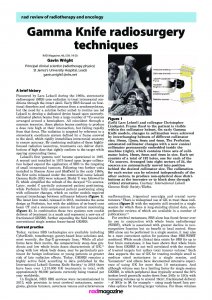Trending
- Huddersfield Royal receives first two of six auto positioning systems
- Medray reps meet familiar faces at ECR
- Envirotect x-ray screen makes a splash at Brighton children’s hospital
- The London Clinic’s rapid diagnostics centre offers same-day appointments
- GenesisCare UK opens specialist centre in Guildford to offer personalised cancer care
- Leadless pacemaker is a game-changer for nurse
- AXREM selects its Future Leaders Council members
- CDC expands medical imaging services in Barnsley Town Centre
- Greater Manchester reaches milestone in go-live to support faster diagnoses through PACS-based reporting
- Hermia brand-independent molecular imaging software enables departments to choose the camera they want
Gamma Knife radiosurgery techniques
Author(s): Gavin Wright
Hospital: St James's University Hospital
Reference: RAD Magazine, 46, 539, 19-20
Excerpt: Pioneered by Lars Leksell during the 1960s, stereotactic radiosurgery (SRS) uses radiation to treat intracranial conditions through the intact skull. Early SRS focused on functional disorders and utilised protons from a synchrocyclotron, but the need for a solution better suited to routine use led Leksell to develop a dedicated device based upon narrowly-collimated photon beams from a large number of 60Co sources arranged around a hemisphere. All coincident through a common isocentre, these photon beams combine to produce a dose rate high at their intersection, but falling rapidly from that focus. The radiation is targeted by reference to a stereotactic coordinate system defined by a frame screwed to the skull, which rigidly immobilises intracranial anatomy to ensure accuracy. By combining multiples of these highly-focused radiation isocentres, treatments can deliver distributions of high dose that tightly conform to the target while sparing surrounding tissue.


